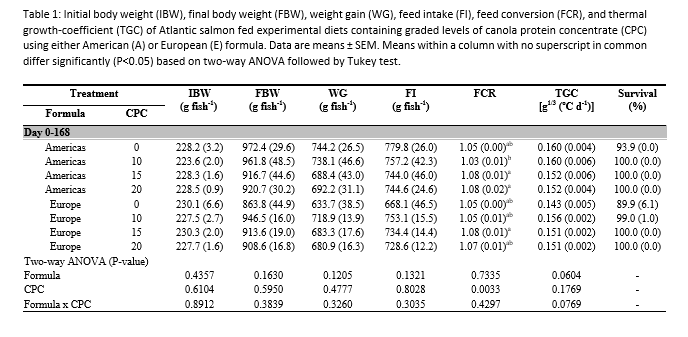NUTRITIONAL EVALUATION OF AN AQUEOUS-PROCESSED OILSEED IN DIETS OF POST-SMOLT ATLANTIC SALMON Salmo salar
The nutritional value of graded inclusion levels of canola protein concentrate (CPC; 75.8% crude protein, 4.4% crude lipid) obtained through aqueous processing was assessed in post-smolt Atlantic salmon over a three-month study. Eight experimental diets containing 0 (Diets A, E), 10% (Diets B, F), 15% (Diets C, G) and 20% (Diets D, H) CPC were randomly allocated to 24 750-liter tanks at 33 fish (228.0 ± 4.9 g) per tank. Diets A through D were formulated to mimic commercial salmon feeds in geographies where processed animal proteins (PAP) are used (Americas), whereas diets E through H included no PAP (Europe).
Overall, growth performances, measured using the thermal-unit growth coefficient (TGC), varied between 0.143 and 0.160, and were not significantly different among treatments (P>0.05) (Table 1). Feed conversion ratios (FCR) were ≤1.08 and, although there was a significant CPC effect (P=0.003), differences were marginal. Over the 168-day study, the best TGC and FCR were obtained with salmon fed 10% CPC, regardless of formula type. However, 20% CPC was optimal for growth and FCR during the first 28 days of this salmon study. Weight gain, TGC and FCR between days 0 and 28 improved in a linear manner (P<0.01) in response to 10-20% CPC. Results on whole-body composition, nutrient deposition and distal intestine histology will be included in the presentation. The apparent digestibility coefficients were 91.1% for protein, 88.8% for lipid and 87.7-99.9% for essential amino acid in CPC. Based on these results, CPC stood as a safe and nutritious protein alternative up to 20% inclusion in salmon diet. The effect of higher inclusion level of CPC in nutrient-balanced diets deserve further studies.
